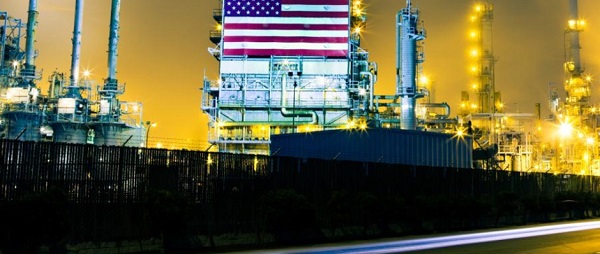Energy
Unleashing American Energy: America’s Silver Bullet

Energy Talking Points by Alex Epstein
|
|
It’s said that in politics there’s no silver bullet that’ll make everything better.
But we do have 1 silver bullet in the chamber: the opportunity to unleash American energy, which Donald Trump has rightly vowed to do.
- The single most important thing government can do to make our lives better—something that will lead to a better economy, a lower cost of living, more job opportunities, a lower deficit, greater security, and a better environment—is unleash abundant, affordable, American energy.
- If we unleash abundant, affordable, American oil, natural gas, and coal production from the anti-energy policies holding it back, we can go from crippling inflation—substantially driven by energy costs—to affordable food, housing, transportation, and heating bills.
- Unleashing American energy will take us from nationwide electricity shortages to affordable, reliable power for all—and from losing good job opportunities to China, which we’ve allowed to outcompete us on energy costs, to creating millions of new well-paying jobs here at home.
- Unleashing American energy will take us from begging OPEC+ for oil, depending on Russia for uranium, and being at China’s mercy for critical minerals, to producing an abundant and secure supply of these crucial commodities at home.
- Many Americans are hesitant to embrace policies that unleash abundant, affordable energy because they think it will harm environmental progress—progress in air and water quality, safety from climate, and enjoyment of nature. Nothing could be further from the truth.
- Environmental progress isn’t in conflict with abundant, affordable energy; it requires abundant, affordable energy—to afford pollution controls, to clean up natural environmental hazards, and to protect ourselves from the always-dynamic and dangerous climate.
- Thanks to abundant, affordable energy, America has been wealthy enough to innovate and adopt pollution controls that make our air far cleaner—which is why America was able to increase its fossil fuel use 25% since 1970 while reducing air pollution 78%.¹
- Thanks to abundant, affordable energy, America has been able to clean up natural environmental hazards such as undrinkable water, which requires affordable, reliable energy to purify, or mosquito-infested swamps, which require abundant, affordable energy to drain.
- Thanks to abundant, affordable energy, we can protect ourselves from the always-dangerous climate by powering heating and A/C systems, storm warning and evacuation systems, and irrigation systems; witness the 98% drop in climate-related disaster deaths over the last century.²
- Thanks to abundant, affordable energy we have the wealth we need to enjoy and preserve the most valuable and beautiful parts of nature—which is why America is able to be both the world’s economic superpower and a place of unsurpassed access to the great outdoors.
- The key to supporting America’s energy abundance and environmental progress is maintaining steadfast support of individual and economic freedom, including the protection of property rights.
- Property rights allow our energy companies to produce and innovate as they judge best. The shale revolution happened here because we alone protect underground property rights. Producers used this freedom to figure out how to extract abundant oil and gas from once-useless rocks.
- Property rights allow us to care for our environment on our own property—and people tend to care best for what they own. And property rights are the basis for laws protecting our air and water from dangerous levels of pollution.
- America has shown time and again that pro-freedom energy and environmental policies drive energy and environmental progress. And we can do it again, if we reverse the anti-freedom policies of the past several decades and embrace the following “energy freedom” policies.
- To aid America in unleashing American energy, I’ve created the Energy Freedom Plan—a comprehensive plan that includes hundreds of high-leverage policy changes for every aspect of energy, from drilling to pipelines to electricity to nuclear to rare earth elements.
- The Energy Freedom Plan is based on 5 game-changing goals:
- Unleash responsible development
- End preferences for unreliable electricity
- Set environmental standards using cost-benefit analysis
- Address climate danger through resilience and innovation
- Unleash nuclear energy
- Unleash responsible development
Anti-development policies prevent the drilling, mining, transporting, and building all energy needs to reach its potential—from natural gas to nuclear to solar.
Liberating responsible development will create unprecedented US energy abundance.
- End preferences for unreliable electricity
Our grid is being ruined by systemic preferences for unreliable electricity, which cause prices to rise and reliability to decline.
Ending these preferences and prioritizing reliability is needed to make power cheap and reliable again.
- Set environmental standards using cost-benefit analysis
The EPA harms prosperity and health via emissions standards that impose huge costs for little or no benefit.
Real cost-benefit analysis, including objective health science will promote prosperity and environmental quality.
- Address climate danger through resilience and innovation, not punishing America
“Climate policy”” that singles out US emissions makes us poorer and less resilient while global emissions go up.
Becoming more resilient and unleashing innovation are the keys to climate safety.
- Unleash nuclear energy from pseudo-scientific restrictions
The strangulation of nuclear has made it 10 times more expensive than it needs to be.
Unleashing nuclear, including getting rid of pseudoscientific policies like LNT and ALARA, will make possible a nuclear renaissance.
- This week I will be releasing the FULL Energy Freedom Plan, including over 100 SPECIFIC game-changing policies that can unleash American energy like never before.
To make sure you see the whole plan, follow me @AlexEpstein and especially subscribe to alexepstein.substack.com.
Questions about this article? Ask AlexAI, my chatbot for energy and climate answers:
Popular links
- EnergyTalkingPoints.com: Hundreds of concise, powerful, well-referenced talking points on energy, environmental, and climate issues.
- My new book Fossil Future: Why Global Human Flourishing Requires More Oil, Coal, and Natural Gas—Not Less.
- Speaking and media inquiries
“Energy Talking Points by Alex Epstein” is my free Substack newsletter designed to give as many people as possible access to concise, powerful, well-referenced talking points on the latest energy, environmental, and climate issues from a pro-human, pro-energy perspective.
Share Energy Talking Points by Alex Epstein
For every million people on earth, annual deaths from climate-related causes (extreme temperature, drought, flood, storms, wildfires) declined 98%–from an average of 247 per year during the 1920s to 2.5 per year during the 2010s.
Data on disaster deaths come from EM-DAT, CRED / UCLouvain, Brussels, Belgium – www.emdat.be (D. Guha-Sapir).
Population estimates for the 1920s from the Maddison Database 2010, the Groningen Growth and Development Centre, Faculty of Economics and Business at University of Groningen. For years not shown, population is assumed to have grown at a steady rate.
Population estimates for the 2010s come from World Bank Data.
Canadian Energy Centre
First Nations in Manitoba pushing for LNG exports from Hudson’s Bay

From the Canadian Energy Centre
By Will Gibson
NeeStaNan project would use port location selected by Canadian government more than 100 years ago
Building a port on Hudson’s Bay to ship natural resources harvested across Western Canada to the world has been a long-held dream of Canadian politicians, starting with Sir Wilfred Laurier.
Since 1931, a small deepwater port has operated at Churchill, Manitoba, primarily shipping grain but more recently expanding handling of critical minerals and fertilizers.
A group of 11 First Nations in Manitoba plans to build an additional industrial terminal nearby at Port Nelson to ship liquefied natural gas (LNG) to Europe and potash to Brazil.
Robyn Lore, a director with project backer NeeStaNan, which is Cree for “all of us,” said it makes more sense to ship Canadian LNG to Europe from an Arctic port than it does to send Canadian natural gas all the way to the U.S. Gulf Coast to be exported as LNG to the same place – which is happening today.
“There is absolutely a business case for sending our LNG directly to European markets rather than sending our natural gas down to the Gulf Coast and having them liquefy it and ship it over,” Lore said. “It’s in Canada’s interest to do this.”
Over 100 years ago, the Port Nelson location at the south end of Hudson’s Bay on the Nelson River was the first to be considered for a Canadian Arctic port.
In 1912, a Port Nelson project was selected to proceed rather than a port at Churchill, about 280 kilometres north.
The Port Nelson site was earmarked by federal government engineers as the most cost-effective location for a terminal to ship Canadian resources overseas.
Construction started but was marred by building challenges due to violent winter storms that beached supply ships and badly damaged the dredge used to deepen the waters around the port.
By 1918, the project was abandoned.
In the 1920s, Prime Minister William Lyon MacKenzie King chose Churchill as the new location for a port on Hudson’s Bay, where it was built and continues to operate today between late July and early November when it is not iced in.
Lore sees using modern technology at Port Nelson including dredging or extending a floating wharf to overcome the challenges that stopped the project from proceeding more than a century ago.
He said natural gas could travel to the terminal through a 1,000-kilometre spur line off TC Energy’s Canadian Mainline by using Manitoba Hydro’s existing right of way.
A second option proposes shipping natural gas through Pembina Pipeline’s Alliance system to Regina, where it could be liquefied and shipped by rail to Port Nelson.
The original rail bed to Port Nelson still exists, and about 150 kilometers of track would have to be laid to reach the proposed site, Lore said.
“Our vision is for a rail line that can handle 150-car trains with loads of 120 tonnes per car running at 80 kilometers per hour. That’s doable on the line from Amery to Port Nelson. It makes the economics work for shippers,” said Lore.
Port Nelson could be used around the year because saltwater ice is easier to break through using modern icebreakers than freshwater ice that impacts Churchill between November and May.
Lore, however, is quick to quell the notion NeeStaNan is competing against the existing port.
“We want our project to proceed on its merits and collaborate with other ports for greater efficiency,” he said.
“It makes sense for Manitoba, and it makes sense for Canada, even more than it did for Laurier more than 100 years ago.”
Energy
Straits of Mackinac Tunnel for Line 5 Pipeline to get “accelerated review”: US Army Corps of Engineers


From the Daily Caller News Foundation
By Audrey Streb
The Army Corps of Engineers on Tuesday announced an accelerated review of a Michigan pipeline tunnel under the Straits of Mackinac following President Donald Trump’s declaration of a “national energy emergency” on day one of his second term.
Enbridge’s Line 5 oil pipeline is among 600 projects to receive an emergency designation following Trump’s January executive order declaring a national energy emergency and expediting reviews of pending energy projects. The action instructed the Army Corps to use emergency authority under the Clean Water Act to speed up pipeline construction.
“An energy supply situation which would result in an unacceptable hazard to life, a significant loss of property, or an immediate, unforeseen, and significant economic hardship,” if not acted upon quickly, the public notice reads.

U.S. President Donald Trump holds up a signed executive order as (L-R) U.S. Treasury Secretary Scott Bessent, Secretary of Commerce Howard Lutnick and Interior Secretary Doug Burgum look on in the Oval Office of the White House on April 09, 2025 in Washington, DC. (Photo by Anna Moneymaker/Getty Images)
“Line 5 is critical energy infrastructure,” Calgary-based Enbridge wrote to the DCNF. The company noted that it submitted its permit applications to state and federal regulators five years ago and described the project as “designed to make a safe pipeline safer while also ensuring the continued safe, secure, and affordable delivery of essential energy to the Great Lakes region.”
Army Corps’ Detroit District did not respond to the DCNF’s request for a copy of the notice or for comment.
The pipeline has been active since 1953 and extends for 645 miles across the state of Michigan, according to the Department of Environment, Great Lakes, and Energy website. Line 5 supplies 65% of the propane needs in Michigan’s Upper Peninsula and 55% of the state’s overall propane demand, according to Enbridge.
The project has faced legal trouble and permitting delays that have hindered its expansion. Michigan Democratic Gov. Gretchen Whitmer in 2019 used a legal opinion by Attorney General Dana Nessel to argue that the law that created the authority to approve the project “because its provisions go beyond the scope of what was disclosed in its title.”
The State of Michigan greenlit the project in 2021 and the Michigan Public Service Commission approved placing the new pipeline segment in 2023.
Trump has championed an American energy production revival, stating throughout his 2024 campaign that he wanted to “drill, baby, drill,” in reference to oil drilling on U.S. soil.
-

 2025 Federal Election2 days ago
2025 Federal Election2 days agoRCMP Whistleblowers Accuse Members of Mark Carney’s Inner Circle of Security Breaches and Surveillance
-

 Also Interesting2 days ago
Also Interesting2 days agoBetFury Review: Is It the Best Crypto Casino?
-

 Autism2 days ago
Autism2 days agoRFK Jr. Exposes a Chilling New Autism Reality
-

 COVID-192 days ago
COVID-192 days agoCanadian student denied religious exemption for COVID jab takes tech school to court
-

 2025 Federal Election2 days ago
2025 Federal Election2 days agoBureau Exclusive: Chinese Election Interference Network Tied to Senate Breach Investigation
-

 International2 days ago
International2 days agoUK Supreme Court rules ‘woman’ means biological female
-

 2025 Federal Election2 days ago
2025 Federal Election2 days agoNeil Young + Carney / Freedom Bros
-

 Health2 days ago
Health2 days agoWHO member states agree on draft of ‘pandemic treaty’ that could be adopted in May










